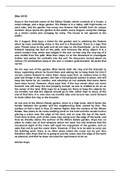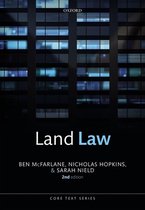[May 2018]
Anya is the freehold owner of the Albion Estate, which consists of a house, a
small cottage, and a large garden. The Estate is in a valley, with high banks on
each side, and the garden has many rare flowers that benefit from its unique
location. Anya opens the garden to the public every August, using the cottage
as a visitor centre and charging for entry. The house is not opened to the
public.
On 2 August, Bilal buys a ticket for the garden and is admiring the flowers
when he sees something shiny in the soil in a flowerbed. There is a sign that
says ‘Please keep to the path and do not step on the flowerbeds’, so he leans
forward, keeping his feet on the path, and removes the shiny object. It is a
small, modern ring, which was lodged in the soil, so that only the very top of it
was visible from the path. Bilal then steps on to the flowerbed to investigate
further and pokes his umbrella into the soil. He discovers, buried about six
inches (15 centimetres) deep in the soil, a modern gold bracelet. He picks that
up too.
On his way out of the garden, Bilal hands both the ring and the bracelet to
Anya, explaining where he found them and asking her to keep them for him if
no-one comes forward to claim them. Anya says that, as visitors have in the
past lost things in the garden, she has a lost property system in place: she will
keep the items for six months, and advertise on her website that some items
have been found. However, Anya says that, if the true owner does not come
forward, she will keep the lost property herself, as she is entitled to do so as
the owner of the land. Bilal says he is happy for Anya to keep the objects for
six months, but that the objects should go to him, rather than to Anya, at the
end of that time. It is now over six months later and no-one has come forward
to claim either the ring or the bracelet.
At one end of the Albion Estate garden, there is a high bank, which forms the
border between the garden and the neighbouring land, owned by Ken. The
surface of Ken’s land is thus 25 metres higher than the surface of the Albion
Estate. Ken plans to do some building work on his land and this would involve
placing a crane near the edge of his land, and so near the top of the bank.
From time to time, part of the crane may swing over the edge of the bank, and
thus be directly above the surface of the Albion Estate garden. Anya has no
plans to make use of that airspace above her land, but she believes that the
occasional sight of the crane will spoil her enjoyment of the garden, and so
asks Ken not to put the crane there. However, if Ken is to be able to carry out
the building work, there is no other place where the crane can be put. Ken
therefore tells Anya that he is going to put the crane near the edge of the bank
as planned, and that he does not need her permission to do so.
Advise Anya.
,Whether A is entitled to keep the ring and bracelet as the landowner
General rule: If the object is a chattel (not part and parcel of the land), the fact that it
is found on the landowner’s land does not give the owner any special rights over
object finder of the object has superior priority right in object than landowner
[Hannah v Peel]
Hence, first need to determine if the ring and bracelet are chattels or fixtures
Depends on two factors [Elitstone Ltd v Morris]
o Degree of annexation to the land
o Objectively determined purpose of annexation
Ring
Ring was easily annexed from the land, as it was merely ‘lodged in the soil’ and B
managed to ‘remove’ it
Ring did not have an objectively valid purpose of being on the land as it did not
contribute to the viewing of the flowers, and was presumably lost by another one of
the visitors
Hence, ring is a chattel
Bracelet
Bracelet is ‘buried six inches deep in the soil’ however, it was still easily annexed
from the land as B managed to uncover it by ‘[poking] his umbrella into the soil’ and
picked it up
Ring did not have an objectively valid purpose of being on the land as it did not
contribute to the viewing of the flowers, and was presumably lost by another one of
the visitors
Hence, bracelet is a chattel
Exceptions
Since both the ring and bracelet are chattels, B has superior property right in these
objects than A should be able to have possession of them
However, there are exceptions to this general rule
Parker: Landowner has superior property right in objects when she manifests an
intention to exercise control over objects found on the land. In such cases, owner is
obliged to take all reasonable measures to ensure the lost chattel is acquainted with
the true owner, and to take care of the chattel in the meanwhile
o A clearly manifests an intention to exercise control over objects found on the
land, as seen in her structured ‘lost property system’, in which the procedure is
that all lost items not reclaimed after 6 months will be kept by A
o A does take reasonable measures – seen in her ‘lost property system’: A gives
true owners a reasonable time frame of 6 months to recover their items, and
‘advertises on her website’ as well
However, court may find that A does not take ‘all reasonable
measures’ as she merely advertises that ‘some items have been found’
instead of explicitly stating what the items are – this is a reasonable
step since it does not take much extra effort, but will be a much clearer
indicator to true owners that A has their specific lost item
, o A takes care of the chattel by keeping it with her in the meantime
Waverley BC v Fletcher: Where an object is found in, rather than on, the land
o In Waverley, held that an object that was 9 inches below the surface was an
object found in the land belonged to the landowner
o Court is unlikely to find that the ring was found in the land, since the ‘very top
of it was [still] visible from the path from the case above, it is clear that an
object is only found in the land when it is buried rather deep, thus it is likely
that an object that is only partially buried still constitutes an object found on
the land finder has superior property right
o However, bracelet was buried ‘about six inches deep in the soil’ although
this is not as deep as 9 inches, court is likely to find that object is found in the
land landowner has superior property right
Parker: Where the finder is a trespasser or was acting dishonestly
o Reason: Public policy
o B was clearly not dishonest as he voluntarily passed both items to A
o A clearly stated on a sign that visitors should ‘keep to the path and … not step
on the flowerbeds’
o With regards to the ring, B did not step on the flowerbed and kept ‘his feet on
the path’ not trespass
o With regards to the bracelet, B stepped ‘on to the flowerbed’ and ‘poked …
into the soil’ trespass
o Court is likely to find that B has superior property right in the ring but not the
bracelet
Hence, court is likely to find that B has the legal right to keep the ring but not the bracelet,
now that the six months has passed
Whether A has the legal right to stop K from putting the crane near the edge of the
bank
General rule: An owner’s rights are not limited to the surface of the land itself, but
also extends to above and below the land
o Above land: Kelsen v Imperial Tobacco Co
o Based on this, A has the legal right to stop K
However, an owner does not have complete and unlimited control over the area above
and below surface of the land
o Above land: Bernstein v Skyviews
o No damages were awarded to Bernstein when Skyviews flew aircraft above
Bernstein without his permission
o Need to balance rights of owner to enjoy his use of land against rights of
general public to use air space
A does not have a very strong claim since A has ‘no plans to make use
of that airspace above her land’, merely thinks that the ‘occasional
sight of the crane will spoil her enjoyment of the garden’
But given that her garden is open to the public to admire flowers, it
may affect the general public’s enjoyment as well
General public use of air space here is not relevant





